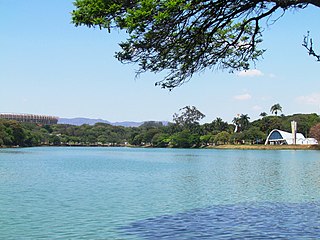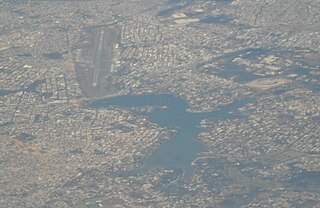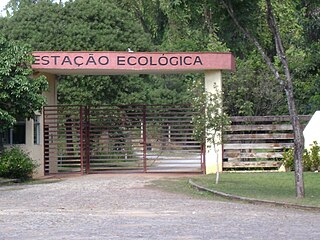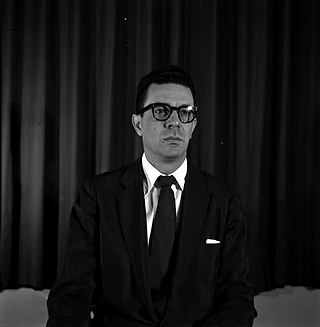
Oscar Ribeiro de Almeida Niemeyer Soares Filho, known as Oscar Niemeyer, was a Brazilian architect considered to be one of the key figures in the development of modern architecture. Niemeyer was best known for his design of civic buildings for Brasília, a planned city that became Brazil's capital in 1960, as well as his collaboration with other architects on the headquarters of the United Nations in New York. His exploration of the aesthetic possibilities of reinforced concrete was highly influential in the late 20th and early 21st centuries.

Belo Horizonte is the sixth-largest city in Brazil, with a population of around 2.7 million, and the third largest metropolitan area, with a population of 6 million. It is the 13th-largest city in South America and the 18th-largest in the Americas. The metropolis is anchor to the Belo Horizonte metropolitan area, ranked as the third most populous metropolitan area in Brazil and the 17th most populous in the Americas. Belo Horizonte is the capital of the state of Minas Gerais, Brazil's second-most populous state. It is the first planned modern city in Brazil.

Juscelino Kubitschek de Oliveira, also known by his initials JK, was a prominent Brazilian politician who served as the 21st president of Brazil from 1956 to 1961. His term was marked by economic prosperity and political stability, being most known for the construction of a new capital, Brasília.

The Guignard University of Art of Minas Gerais is a university of fine arts in Belo Horizonte, Minas Gerais, Brasil. It was founded on 28 February 1944 by the Brazilian painter Alberto da Veiga Guignard (1896-1962) on request of Juscelino Kubitschek, mayor of Belo Horizonte and later President of Brazil. Guignard became a noted arts educator in Brazil and remained a professor at Guignard for the remainder of his life.

Lake Pampulha is an artificial lake located in Pampulha, Belo Horizonte, Brazil. It is also the name of an administrative region of Belo Horizonte, and the name of one of 29 neighborhoods (bairros) within the administrative region of the same name. The lake was built in the early 1940s during the mayoralty of Juscelino Kubitschek, later president of Brazil from 1956 to 1961. Pampulha was created as a source of water for the city of Belo Horizonte, but quickly became polluted.

The Church of Saint Francis of Assisi is a chapel in Pampulha region of Belo Horizonte, in the state of Minas Gerais, southeastern Brazil. It was designed by the Brazilian architect Oscar Niemeyer in the organic modern style. It is the first listed modern architectural monument in Brazil and consists of four undulating concrete parabolas with outdoor mosaics. The interior hosts a mural by Candido Portinari, and the exterior features a landscape designed by Roberto Burle Marx.

The Praça Rui Barbosa, also called Praça da Estação, is a square in Belo Horizonte, Brazil.

BR-040 is a federal highway of Brazil. The 1,139.3 kilometres (707.9 mi) road connects Brasilia to Rio de Janeiro.
Universal Transportes Aéreos was a Brazilian airline founded in 1947. In December 1948 it ceased operations.
NAB – Navegação Aérea Brasileira was a Brazilian airline founded in 1938. In 1961 it was sold to Lóide Aéreo Nacional.
Juscelino Kubitschek was the President of Brazil between 1956 and 1961. Many places were named after him, including:

Pampulha is an administrative region in the city of Belo Horizonte, Brazil. It is one of nine administrative regions of Belo Horizonte, and occupies 47.13 kilometres (29.29 mi) in the northeast of the city. It has a population of 145,262 and a population density of 3.08 per square kilometer. The center of the Pampulha is occupied by Lake Pampulha, an artificial lake constructed in the early 1940s by Mayor Juscelino Kubitschek, later president of Brazil from 1956 to 1961. The Pampulha administrative region is further subdivided into 29 neighborhoods (bairros), one of which is also called Pampulha.

The Pampulha Modern Ensemble is an urban project in Belo Horizonte, Minas Gerais, Brazil. It was designed around an artificial lake, Lake Pampulha, in the district of Pampulha and includes a casino, a ballroom, the Golf Yacht Club and the Church of Saint Francis of Assisi. The buildings were designed by the architect Oscar Niemeyer, in collaboration with the landscape architect Roberto Burle Marx, Brazilian Modernist artists, and engineer Joaquim Cardozo.

The Federal University of Minas Gerais Ecological Station is an ecological station in the state of Minas Gerais, Brazil.

Paul Clemence is an American-Brazilian photo-artist, focused on registering the expressive side of the built environment, particularly architecture. Beyond exhibiting his artwork, he lectures frequently and has authored several books.

Sylvio Carvalho de Vasconcellos was a Brazilian architect and architectural historian, also recognized as one of the pioneers of Brazilian modernist architecture in the state of Minas Gerais.

The Iate Tênis Clube is a recreational club located on the shore of the Lake Pampulha in Belo Horizonte. Its building was designed by architect Oscar Niemeyer in the early 1940s, integrating the Pampulha Architectural Complex, recognized by UNESCO as a World Heritage Site since 2016.

The Pampulha Art Museum, formerly known as Cassino da Pampulha, is a building that is part of the Pampulha Modern Ensemble located in Belo Horizonte, Minas Gerais, Brazil. The building was designed by the architect Oscar Niemeyer at the request of the then-mayor of the city, Juscelino Kubitschek, and is recognized by UNESCO as a World Heritage Site along with the rest of the ensemble since 2016.

The Casa do Baile is an architectural landmark in Belo Horizonte, Brazil, designed by Brazilian architect Oscar Niemeyer. It is part of the Pampulha Modern Ensemble, a complex of buildings constructed around Lake Pampulha in the 1940s that represents some of Niemeyer's earliest works in his distinctive modernist style utilizing curved forms. The Casa do Baile was inaugurated in 1943 as a restaurant and dance hall for popular entertainment, though it had a short lifespan in that role. After years of alternate uses, it reopened in 2002 as an architecture and design center. Its fluid curves integrating with the natural landscape have made it an icon of modern Brazilian architecture, garnering protected status at municipal, state and national levels.


















